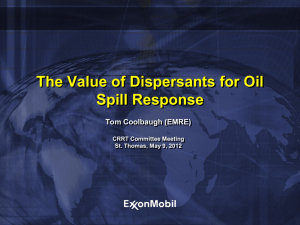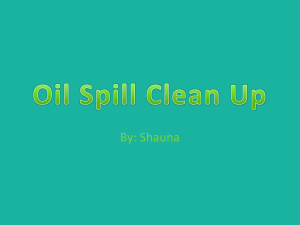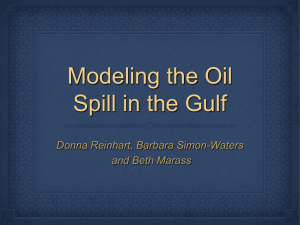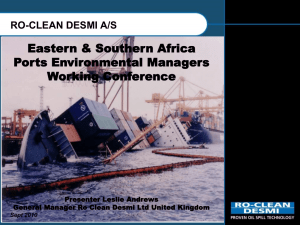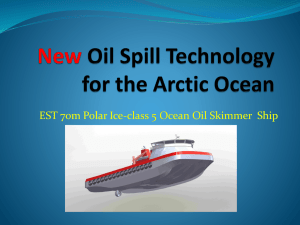Oil Spill Dispersants
advertisement
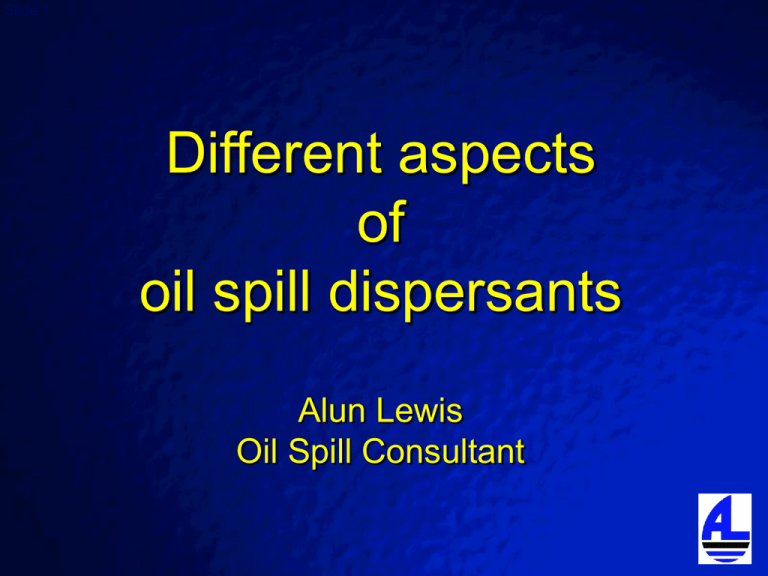
Slide 1 © 2003 By Default! Different aspects of oil spill dispersants Alun Lewis Oil Spill Consultant A Free sample background from www.powerpointbackgrounds.com Slide 2 © 2003 By Default! Purpose of Workshop “To develop decision trees and guidance for dispersant use in the Netherlands EEZ of the North Sea” Having a national policy regarding dispersant use does not imply that dispersant use will be automatically allowed in all (or perhaps any) areas of the Netherlands EEZ The guidance will provide the framework for rational decisions to be made A Free sample background from www.powerpointbackgrounds.com Slide 3 © 2003 By Default! Important points Dispersants are used to remove oil from the surface of the sea – If dispersed in deeper water, the spilled oil will not drift into shallow water where most damage is caused – Coastal habitats will not be polluted with oil Successful use of dispersants inevitably means that oil is transferred into water column – Damage caused by dispersed oil is not inevitable – Dispersion followed by adequate dilution causes relatively little effect A Free sample background from www.powerpointbackgrounds.com Slide 4 © 2003 By Default! Three main questions about dispersants 1. Will dispersants work? – 2. Will dispersing the oil do more good than harm? – 3. Sometimes, but not every time and not under all circumstances Any oil spill response that causes more damage than the spilled oil is pointless. If dispersion of oil would cause more harm than good, don’t do it! How should dispersants be used? – – Dispersant “approval” Strategic and operational issues A Free sample background from www.powerpointbackgrounds.com Slide 5 © 2003 By Default! 1. Will dispersants work? Dispersion of spilled oil is a natural process caused by wave action – Low viscosity oils in very rough sea conditions naturally disperse (e.g. the Braer incident in 1993) – But natural dispersion stops when an oil ‘weathers’ Adding dispersant enhances this natural process – Higher viscosity oils in calmer sea conditions will disperse when dispersant is added There are limits to dispersant capabilities – High viscosity oils cannot be dispersed – Limiting viscosity depends on sea-state A Free sample background from www.powerpointbackgrounds.com Emulsification Water depth (m) 0 1 2 3 Natural dispersion 4 5 Workshop on the use of oil spil dispersants in the North Sea Emulsification Water depth (m) 0 1 2 3 Natural dispersion 4 5 Workshop on the use of oil spil dispersants in the North Sea Emulsification Water depth (m) 0 1 2 3 Natural dispersion 4 5 Workshop on the use of oil spil dispersants in the North Sea Emulsification Water depth (m) 0 1 2 3 Natural dispersion 4 5 Workshop on the use of oil spil dispersants in the North Sea Emulsification Water depth (m) 0 1 2 3 Natural dispersion 4 5 Workshop on the use of oil spil dispersants in the North Sea Emulsification Water depth (m) 0 1 2 3 Natural dispersion 4 5 Workshop on the use of oil spil dispersants in the North Sea Emulsification Water depth (m) 0 1 2 3 Natural dispersion 4 5 Workshop on the use of oil spil dispersants in the North Sea Water depth (m) 0 1 2 3 4 5 Workshop on the use of oil spil dispersants in the North Sea Oil layer thickness (mm) 0 0.5 Workshop on the use of oil spil dispersants in the North Sea Oil layer thickness (mm) 0 0.5 Workshop on the use of oil spil dispersants in the North Sea Oil layer thickness (mm) 0 0.5 Workshop on the use of oil spil dispersants in the North Sea Oil layer thickness (mm) 0 0.5 Workshop on the use of oil spil dispersants in the North Sea Oil layer thickness (mm) 0 0.5 Workshop on the use of oil spil dispersants in the North Sea Oil layer thickness (mm) 0 0.5 Workshop on the use of oil spil dispersants in the North Sea Oil layer thickness (mm) 0 0.5 Workshop on the use of oil spil dispersants in the North Sea Oil layer thickness (mm) 0 0.5 Workshop on the use of oil spil dispersants in the North Sea Oil layer thickness (mm) 0 0.5 Workshop on the use of oil spil dispersants in the North Sea Oil layer thickness (mm) 0 0.5 Workshop on the use of oil spil dispersants in the North Sea Oil layer thickness (mm) 0 0.5 Workshop on the use of oil spil dispersants in the North Sea After many hours… Oil layer thickness (mm) 0 0.5 Workshop on the use of oil spil dispersants in the North Sea Slide 26 © 2003 By Default! The effect of dispersants The active ingredients in dispersants (the surfactants) greatly reduce the high interfacial tension between oil and water Surfactants act as a bridge between the oil and water – The chemical barrier between oil and water is almost totally removed Mixing of the dispersant-treated oil and water by waves causes very small oil droplets to be formed – These will not float out anywhere near as fast A Free sample background from www.powerpointbackgrounds.com Chemically enhanced dispersion Water depth (m) 0 1 Spray dispersant onto spilled oil 2 3 4 5 Workshop on the use of oil spil dispersants in the North Sea Dispersant enhanced dispersion Water depth (m) 0 1 2 3 4 5 Workshop on the use of oil spil dispersants in the North Sea Dispersant enhanced dispersion Water depth (m) 0 1 2 3 4 5 Workshop on the use of oil spil dispersants in the North Sea Dispersant enhanced dispersion Water depth (m) 0 1 2 3 4 5 Workshop on the use of oil spil dispersants in the North Sea Dispersant enhanced dispersion Water depth (m) 0 1 2 3 4 5 Workshop on the use of oil spil dispersants in the North Sea Dispersant enhanced dispersion Water depth (m) 0 1 2 3 4 5 Workshop on the use of oil spil dispersants in the North Sea Dispersant enhanced dispersion Water depth (m) 0 1 2 3 4 5 Workshop on the use of oil spil dispersants in the North Sea Dispersant enhanced dispersion Water depth (m) 0 1 2 3 4 5 Workshop on the use of oil spil dispersants in the North Sea Dispersant enhanced dispersion Water depth (m) 0 1 2 3 4 5 Workshop on the use of oil spil dispersants in the North Sea Dispersant enhanced dispersion Water depth (m) 0 1 2 3 4 5 Workshop on the use of oil spil dispersants in the North Sea Dispersant enhanced dispersion Water depth (m) 0 1 2 3 4 5 Workshop on the use of oil spil dispersants in the North Sea Dispersant enhanced dispersion Water depth (m) 0 1 2 3 4 5 Workshop on the use of oil spil dispersants in the North Sea Dispersant enhanced dispersion Water depth (m) 0 1 2 3 4 5 Workshop on the use of oil spil dispersants in the North Sea Dispersant enhanced dispersion Water depth (m) 0 1 2 3 4 5 Workshop on the use of oil spil dispersants in the North Sea Dispersant enhanced dispersion Water depth (m) 0 1 2 3 4 5 Workshop on the use of oil spil dispersants in the North Sea Dispersant enhanced dispersion Water depth (m) 0 1 2 3 4 5 Workshop on the use of oil spil dispersants in the North Sea Dispersant enhanced dispersion Water depth (m) 0 1 2 3 4 5 Workshop on the use of oil spil dispersants in the North Sea Slide 44 © 2003 By Default! Dispersion of small oil droplets Small dispersed oil droplets will be rapidly diluted by the water motion that exists under waves – They are kept in top few metres by water motion under all waves (not just breaking waves) – As they rise up due to limited buoyancy, they are then pushed back down again into the water – Normally penetrate only the top 10 metres of water, but can go deeper in rougher seas – Small dispersed oil droplets do not sink to the bottom – Dispersed oil is rapidly biodegraded to a large extent by natural micro-organisms in the sea A Free sample background from www.powerpointbackgrounds.com Slide 45 © 2003 By Default! 1. Will dispersants work? Consider this question first – If a dispersant does not work there is no point considering the potential consequences (positive and negative) of dispersing the oil Decision-tree based on: – – – – Should dispersants be used on the spilled oil? Can the spilled oil be dispersed? For how long will it be dispersible? Are the sea conditions suitable for dispersion? A Free sample background from www.powerpointbackgrounds.com Slide 46 © 2003 By Default! 2. Is the spilled oil of a type that is dispersible? YES OR NO 3. Is the oil likely to be within the time “window of opportunity’ for dispersant use? YES OR NO 4. Are the sea conditions suitable for dispersion? YES OR NO USE DISPERSANT A Free sample background from www.powerpointbackgrounds.com DO NOT USE DISPERSANT 1. Should dispersants be used on the type of spilled oil? YES OR NO Slide 47 © 2003 By Default! Oil type DISPERSE? WHY? Gasoline NO Dispersants would work, Kerosene (Jet fuel) NO but would force toxic Marine Gas Oil NO components of oil into Marine Diesel Oil NO water column Crude oil (paraffinic) YES Until the time Crude oil (naphthenic) YES “Window of opportunity” Crude oil (asphaltic) YES runs out MAYBE Pour Point? Crude oil (waxy) Hydraulic oil NO Lube oil NO IFO-30 YES Until the time IFO-80 YES “Window of opportunity” IFO-180 YES runs out IFO-380 MAYBE Only at high sea temperature or rough sea IFO-500 NO Viscosity too high IFO-700 NO Viscosity too high A Free sample background from www.powerpointbackgrounds.com Slide 48 © 2003 By Default! Is the spilled oil dispersible? Oil type DISPERSIBLE FOR HOW LONG? Crude oil (paraffinic) YES Until the time Crude oil (naphthenic) YES “Window of opportunity” Crude oil (asphaltic) YES runs out MAYBE Pour Point? IFO-30 YES Until the time IFO-80 YES “Window of opportunity” IFO-180 YES runs out IFO-380 MAYBE Only at high temperature or rough sea Crude oil (waxy) A Free sample background from www.powerpointbackgrounds.com Slide 49 © 2003 By Default! Oil “weathering” and the “window of opportunity” for dispersant use Crude oils and residual fuel oils are not pure chemicals – Consist of an almost infinitely variable mixture of hydrocarbons Each individual crude oil and fuel oil will ‘weather’ at a specific rate that depends on: – Temperature (mainly sea temperature) • High temperature causes rapid evaporation of volatile components and therefore rapid viscosity increase – Wind speed and sea state • High wind speed and rough seas cause high rate of natural dispersion, but also rapid emulsification A Free sample background from www.powerpointbackgrounds.com Slide 50 © 2003 By Default! The problem of “knowns and unknowns” After Donald Rumsfeld Does the “window of opportunity” for dispersant use have to be determined precisely for every single oil that is transported through the Netherlands EEZ of the North Sea? – No • A great deal of information is already available and can be used – Oil spill response is often about informed judgements, not scientific precision • EMSA recently sponsored the development of a simple tool that gives an indication of the window of opportunity based on available information A Free sample background from www.powerpointbackgrounds.com Slide 51 © 2003 By Default! Viscosity limits for dispersion There are no accurate general oil viscosity limits for dispersion. However, with a good dispersant: Dispersion usually possible up to 5,000 cSt Dispersion sometimes possible between 5,000 and 10,000 cSt Dispersion unlikely when viscosity above 10,000 – 20,000 cSt A Free sample background from www.powerpointbackgrounds.com Slide 52 © 2003 By Default! Sea conditions & wind speed for dispersion Dispersants require some breaking wave action to work well – Wind speed of at least 7 knots (Beaufort Force 2 to 3) for rapid dispersion of oil – If sea is very calm and dispersant is applied there will be no rapid dispersion, but this will happen when and if the sea gets rougher Conditions can be too rough for effective dispersant spraying – Spilled oil becomes submerged by waves for a lot of the time A Free sample background from www.powerpointbackgrounds.com Slide 53 © 2003 By Default! Beaufort Force 2 – Light breeze – 4 to 6 knot wind No breaking waves: Dispersant can be sprayed, but will not cause rapid dispersion of spilled oil A Free sample background from www.powerpointbackgrounds.com Slide 54 © 2003 By Default! Beaufort Force 7 – Near Gale - 28 to 33 knot wind Starting to get too rough, but if the crew can do it, dispersant spraying still possible A Free sample background from www.powerpointbackgrounds.com Slide 55 © 2003 By Default! Conditions suitable for dispersion 50 TOO ROUGH Mean wind speed (knots) 45 40 35 30 25 20 15 10 5 0 0 1 2 3 A Free sample background from www.powerpointbackgrounds.com 4 5 6 Beaufort Force 7 8 9 10 Slide 56 © 2003 By Default! Information needed for the Netherlands EEZ of the North Sea Crude oil and residual fuel oil types transported – “Safety at Sea” project has already identified major imports, exports and trades in crude oils and Heavy Fuel Oils Typical sea temperature range – Summer and winter temperatures at key locations Statistical wind speed frequencies – Wind roses at key locations All of this information is available somewhere A Free sample background from www.powerpointbackgrounds.com Slide 57 © 2003 By Default! 2. Will dispersing the oil do more good than harm? If the dispersant would work, i.e. disperse the spilled oil, will the use of dispersant reduce the overall damage that would have been caused by the oil spill? There is no generic answer of “Yes” or “No” It all depends on the specific circumstances of the oil spill A Free sample background from www.powerpointbackgrounds.com Slide 58 © 2003 By Default! Benefits and Risks of dispersant use Dispersing the spilled oil into the water column can be beneficial – Spilled oil is removed from the sea surface and will not drift ashore or into shallow water where it does most damage Dispersing the spilled oil into the water column may pose a risk to some marine organisms – Risk of harm is an effect of exposure and can be small if dilution is sufficient Does the potential benefit justify the potential risk? – Net Environmental Benefit Analysis (NEBA) A Free sample background from www.powerpointbackgrounds.com Slide 59 © 2003 By Default! Over-simplification can lead to incorrect conclusions The decision to use, or not to use, dispersants is sometimes seen as a simple balance between: – The impact on resources most harmed by spilled oil on the sea surface and the coast • Seabirds, coastal species and habitats, tourist beaches, etc. – The impact on resources most harmed by dispersed oil • Marine organisms, i.e. fish and shellfish Use dispersants and the seabirds “win” – but the fish “lose” Do not use dispersants and the fish “win” – but the birds “lose” A Free sample background from www.powerpointbackgrounds.com Slide 60 © 2003 By Default! Marine organisms A Free sample background from www.powerpointbackgrounds.com Seabirds Coastal species Tourism Slide 61 © 2003 By Default! Seabirds Coastal species Tourism Marine organisms Use dispersants A Free sample background from www.powerpointbackgrounds.com Slide 62 © 2003 By Default! Marine organisms Seabirds Coastal species Tourism Do not use dispersants A Free sample background from www.powerpointbackgrounds.com Slide 63 © 2003 By Default! But it is often much more complicated than that The ‘choice’ is often not simply between the effects on the ‘resources’ of: – Spilled oil on the sea surface – Dispersed oil in the water column Spilled oil does damage in various ways to various organisms and resources – Not all resources will be present, or in equal proportion, or are of equal priority – Response actions can only modify some of the impacts of spilled oil Provided that there is adequate dilution, in many circumstances dispersed oil will cause only limited and temporary effects A Free sample background from www.powerpointbackgrounds.com Slide 64 © 2003 By Default! Damage caused by spilled oil The damage caused by oil spills may be caused by: – Water-soluble crude oil components • Exert toxic effects on marine organisms – Spilled oil on the surface of the sea • Contaminates the plumage of seabirds – Spilled oil that drifts into shallow water and ashore • • • • Smothers some coastal organisms, Poisons some benthic organisms Pollutes benthic and coastal habitats Pollutes socio-economic resources such as fishermen’s nets and tourist beaches – Dispersed oil in the water column • Ingested by some organisms, especially filter-feeder shellfish A Free sample background from www.powerpointbackgrounds.com Slide 65 © 2003 By Default! “Toxic effects” Lethal or sub-lethal – Mortality (death) is a very unsubtle indicator of toxicity – Sub-lethal effects can alter feeding or breeding behaviour Acute or chronic – Short-term, non-persistent or long-term and persistent Reversible or irreversible – ‘Tainting’ of fish flesh is reversible, carcinogenic effects are not Effects on individuals or populations? – Some individuals may be damaged / killed, but is the species population affected? Toxic effects are proportional to exposure (Concentration and period of exposure) A Free sample background from www.powerpointbackgrounds.com Slide 66 © 2003 By Default! Physical effects of dispersant use Water-soluble crude oil components Maybe increased (if used very soon after spill) Spilled oil on the surface of the sea Reduced Spilled oil that drifts into shallow water and ashore Reduced Dispersed oil in the water column Increased A Free sample background from www.powerpointbackgrounds.com Slide 67 © 2003 By Default! Consequences of dispersant use Water-soluble crude oil components – Toxic effects on marine organisms Spilled oil that drifts into shallow water and ashore – – – – (if used very soon after spill) Spilled oil on the surface of the sea – Contaminates the plumage of seabirds Maybe increased Smothers some coastal organisms Poisons some benthic organisms Pollutes benthic and coastal habitats Pollutes socio-economic resources such as fishermen’s nets and tourist beaches Reduced Reduced Reduced Reduced Reduced Dispersed oil in the water column – Ingested by some organisms, especially filter-feeder shellfish A Free sample background from www.powerpointbackgrounds.com Increased Slide 68 © 2003 By Default! Dispersant use and fisheries Dispersant use is often of great concern to fishermen – The concern is that dispersing the oil into the water column will inevitably harm the fish stocks – The concern is both financial (short-term and long-term) and ecological Most importantly, oil spills pose a threat to public health through contamination of the food chain – Fishing bans introduced when oil spills happen – The implications of dispersant use need to be taken into account A Free sample background from www.powerpointbackgrounds.com Slide 69 © 2003 By Default! Marine ecological habitats and their inhabitants Pelagic – open water, upper layers – Roundfish: Herring, mackerel, sardines, sprats, bass, mullet Demersal – near the sea bed – Flatfish: Dover sole, plaice, flounder, turbot, monkfish and rays Benthic – on (and in) the seabed – Flat fish; plaice, rays – Crustaceans: Lobster, crabs, crawfish, Nethrops and shrimp – Molluscs: Cockles, mussels, scallops, oysters, clams, whelks, periwinkles, cuttlefish & squid A Free sample background from www.powerpointbackgrounds.com Slide 70 © 2003 By Default! Effects of oil spills on fish There is no evidence to date that any oil spill has killed sufficient numbers of adult fish, or early stages, in the offshore open ocean to significantly affect the population The potential for damage is greater in inshore waters – Adult fish swim away from spilled oil (if they can) Fish plankton can be affected – But fish ‘over-produce’ larvae in huge numbers to overcome predation Oil-polluted sediments can have an adverse effect on benthic species (bottom-dwellers, such as flatfish) Oil spills do affect inshore shellfish beds A Free sample background from www.powerpointbackgrounds.com Slide 71 © 2003 By Default! Dispersants and fisheries Do not use dispersants: – In shallow water (less than ~ 10m) where dispersed oil at high concentration will come into contact with the seabed • However, dispersant use reduces the tendency of dispersed oil to stick to sediment and persistent oil pollution of sediments will be lessened if dispersants are used – Near inshore fish spawning areas and nurseries – Near shellfish beds – Near aquaculture facilities A Free sample background from www.powerpointbackgrounds.com Slide 72 © 2003 By Default! 1. What resources are at risk of damage by spilled oil? 2. Are the resources more sensitive to: (a) Dispersed oil (b) Spilled oil on the surface (c) Oil that drifts ashore NO YES YES UNKNOWN OR OR OR YES NO NO 3. Is the water deep enough for dispersion without threatening benthic organisms? YES OR NO 4. Is the spilled oil far enough away from shore for dispersion? YES OR NO 5. Is the spilled oil far enough away from resources particularly sensitive to dispersed oil? YES OR NO USE DISPERSANT A Free sample background from www.powerpointbackgrounds.com DO NOT USE DISPERSANT KNOWN Slide 73 © 2003 By Default! Every question poses another question What water depth is sufficient for dispersion? – Dispersed oil is slightly buoyant so will tend to stay in upper water layers, the well-mixed zone – 10 metre penetration is typical in moderate sea states • (Beaufort Force wind speed 3 to 7) – Goes deeper in very rough seas – Diluted as it enters deeper water What distance is far enough away for dispersion? – Depends on prevailing currents – 0.5 nautical mile or 1 nautical mile are distances typically used A Free sample background from www.powerpointbackgrounds.com Slide 74 © 2003 By Default! How to present all this information? On marine charts as sensitivity maps Include: – Coastal sensitivity to oil pollution based on shoreline type – Coastal ecology • Habitat types and species population • Seasonal variations – Marine ecology sensitivity maps • Commercial fisheries • Sea bed types mapped by MESH will give an indication of marine habitats and probable species – 10 and 20 metre water depths – Particularly sensitive resources • ecological and socio-economic resources RETURN TO THIS LATER A Free sample background from www.powerpointbackgrounds.com Slide 75 © 2003 By Default! 3. How should dispersants be used? A Free sample background from www.powerpointbackgrounds.com Slide 76 © 2003 By Default! Dispersant “approval” and the law Dispersant “approval” – There are two separate issues: • Dispersant product approval (an “approved” dispersant list) • Dispersant use approval (when and where dispersants can be used) Legislation and regulation of dispersant use – Why is this needed? – Depends on national laws and regulations controlling the release of chemicals into the sea A Free sample background from www.powerpointbackgrounds.com Slide 77 © 2003 By Default! Dispersant “approval” Two separate issues (often confused): – Dispersant product approval • Need to ensure that dispersant is of: – Maximum permitted toxicity – Minimum permitted effectiveness – Dispersant use approval • Need to ensure that the use of dispersant does not cause more harm than good, i.e. make the oil spill damage worse, rather than better A Free sample background from www.powerpointbackgrounds.com Slide 78 © 2003 By Default! Dispersant product approval Not incident- or site-specific; is national Toxicity testing – Need not involve oil; aim is to ensure that the dispersant is not too toxic for use – Conduct a simple, standardised toxicity test (e.g.96 hour LC50 procedure) on some marine species – Not a simulation of dispersant use at sea Effectiveness testing – Use a ‘typical’ oil in an easy-to-repeat test – Not a realistic simulation of dispersion at sea – Set “pass mark” A Free sample background from www.powerpointbackgrounds.com Slide 79 © 2003 By Default! Dispersant use approval Is incident- and site-specific No toxicity testing involved – Judgement of whether dispersed oil would cause a hazard based on knowledge of: • water depth • water flow • sensitivity to dispersed oil of resources near spill location – Use the marine charts containing relevant information to define dispersant use and non-use zones A Free sample background from www.powerpointbackgrounds.com Slide 80 © 2003 By Default! Dispersant use zones used in France Uses spill amount, distance and water depth to produce maximum permitted dispersed oil concentration of 10 ppm Spilled oil (tonnes) 10 100 1000 A Free sample background from www.powerpointbackgrounds.com Distance from shore (nautical miles) 0.5 1.0 2.5 Water depth (metres) 5 10 15 Slide 81 © 2003 By Default! Land Dispersant use permitted on Up to 10 tonnes oil 10 - 100 tonnes oil 100 - 1000 tonnes oil A Free sample background from www.powerpointbackgrounds.com More than1000 tonnes oil Slide 82 © 2003 By Default! Dispersant use zones Dispersant use permitted Dispersant use permitted only with specific prior permission Dispersant use not permitted A Free sample background from www.powerpointbackgrounds.com Slide 83 © 2003 By Default! How to build up dispersant use / non-use zones 1. General limits set by water depth – Define water depth where dispersant use will not be allowed under any circumstances red zone • For example, less than 10 metres* – Define water depth where dispersant use will be permitted without restriction green zone • For example, 20 metres* or more – Zone in between is amber zone *Water depths based on charts will be LAT (Lowest Astronomical Tide) and real water will almost always be deeper A Free sample background from www.powerpointbackgrounds.com Slide 84 © 2003 By Default! How to build up dispersant use / non-use zones 2. Put coastal and marine sensitivities on chart – – – Shoreline types, habitats species populations Establish priorities for protection Decide what is more sensitive to: • Spilled oil on the sea surface • Dispersed oil 3. Modify size and position of zones to reflect sensitivities and protection priorities – Try to eliminate amber zones where possible A Free sample background from www.powerpointbackgrounds.com Slide 85 © 2003 By Default! How to build up dispersant use / non-use zones 4. Consider water movement caused by ebb and flood of tides – – Restrict dispersant use to prevent dispersed oil coming onto mudflats with the tide Only allow spraying when tide is going out A Free sample background from www.powerpointbackgrounds.com Slide 86 © 2003 By Default! Conclusions There are several sets of “decision trees” that could form guidance for decisions about dispersant use in the Netherlands EEZ of the North Sea This information should not stand alone, but be part of the Netherlands National Contingency Plan (NCP) – The essential part is a comprehensive sensitivity map / chart of the Netherlands EEZ of the North Sea – This enables rational decisions to be made about any oil spill response (including dispersant use) A Free sample background from www.powerpointbackgrounds.com Slide 87 © 2003 By Default! The simple decision making process can then be reduced to: Will dispersants work? – Consult subsidiary decision trees YES 2. 3. OR NO Will dispersing the oil do more good than harm? – Consult dispersant use / non-use zones on charts YES OR NO How should dispersants be used? – Approved dispersants available? YES USE DISPERSANT A Free sample background from www.powerpointbackgrounds.com OR NO DO NOT USE DISPERSANT 1. Slide 88 © 2003 By Default! But how could we actually use dispersants? See later: STRATEGIC AND OPERATIONAL ASPECTS OF THE APPLICATION OF DISPERSANT BY AIRCRAFT Chris Francis A Free sample background from www.powerpointbackgrounds.com
